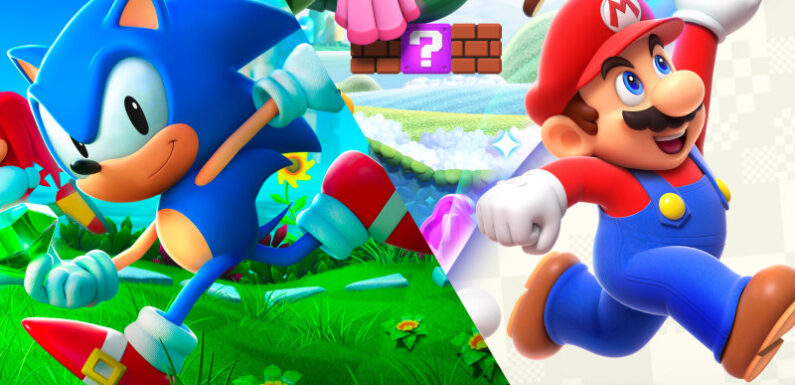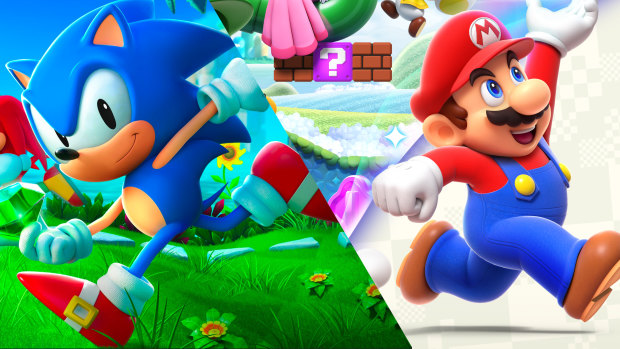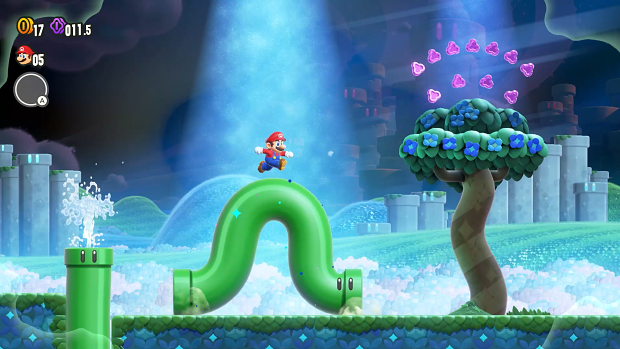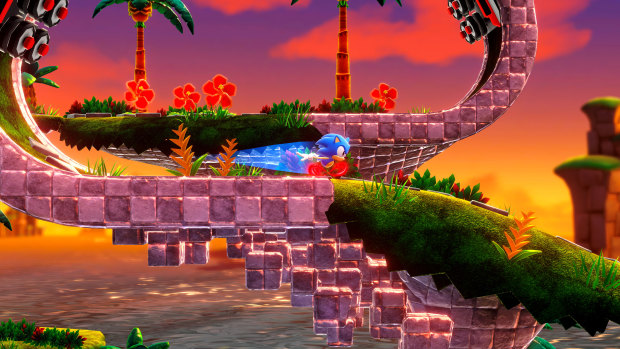
Save articles for later
Add articles to your saved list and come back to them any time.
In 1993, there were no bigger names in video games than Nintendo’s Super Mario and Sega’s Sonic the Hedgehog. And now, 30 years later, the pair are revisiting an old rivalry with two new games — released in the same week — that each dig into their respective mascot’s 2D platforming roots.
Super Mario Bros. Wonder and Sonic Superstars share many similarities and are both, improbably, excellent modernisations that should delight hardcore fans and newcomers alike. But many of their differences, and the gulf between the two in terms of confidence and polish, remind us definitively who came out on top after that war in the ’90s.
The new Sonic and Mario games both return to a 2D format, both support up to four players at a time, and both reflect past games.
Mario Wonder is an impeccable showcase of creativity and a technical masterclass. Borrowing the tight, precise controls of the ’90s games, which have persisted through the years in four “New Super Mario Bros” games, it reinvents almost everything else to stand shoulder-to-shoulder with its blockbuster 3D siblings such as Mario Galaxy and Mario Odyssey when it comes to presentation and delight.
An all-new visual style heavy on expressive animation, and a new approach to sound that fills each level with atmospheric tunes and instrumental takes on classic sound effects sells everything from enemy reactions to the new power-ups (Elephant, Bubble and Drill) to perfection. Meanwhile, a change in scenery – from the usual Mushroom Kingdom to the supposedly nearby Flower Kingdom – justifies hilarious new enemies, intriguingly different locations and surprising level mechanics.
But while all this would make for a solid 2D Mario on its own, the introduction of so-called Wonder Effects is what elevates the game. Finding and touching a Wonder Flower in each level warps the world unpredictably; oftentimes funny, sometimes challenging, usually completely cooked. Mario might be turned into a Goomba or stretched out into an uncomfortably tall man, huge raindrops you can swim through might fall slowly from the sky, or the whole scene could become an interactive opera.
Even the approach to difficulty is fresh. There are seven characters you can choose from who all play the same, or for an easier time there are five who do not take damage. Over time, you also unlock various badges with a range of effects, so an expert player can give themselves a more powerful spin jump, while someone who needs a hand with some of the trickier jumps can add extra blocks to every level.
An early Wonder Effect sees the familiar green pipes become strange worms.
Mario Wonder went straight to the top of the charts on release in some countries (and straight to number two under Spider-man in others), which is not surprising. In contrast to its days of fighting for supremacy with Sega, Nintendo today owns the most popular gaming console on the market, has carved out its own niche to separate it from Sony and Microsoft, and has an essentially flawless track record for publishing top-tier games over the past decade.
Part of this is down to its size — in a series of developer diaries the team behind Super Mario Bros. Wonder say they had essentially unlimited time and budget to create the game — but it’s also in large part down to its culture.
Leading development on Wonder was Takashi Tezuka — who’s been making Super Mario for almost 40 years, starting with the original which he designed alongside Shigeru Miyamoto — and the much younger Shiro Mouri, who also directed the most recent 2D Mario Games, with this focus on mentorship and cross-generational work being an intentional part of keeping Nintendo’s approach to game-making alive. They also had support from Koichi Hayashida, who was central to the development of almost every 3D Mario game, and were able to solicit thousands of ideas for Wonder Effects from various staff.
By contrast, Sega is a vastly different company now than it was 30 years ago, having been acquired by pachinko giant Sammy in the early 2000s after being forced to stop making its own game consoles. It still produces several blockbuster franchises through its developers and subsidiaries, but it does not have the same bench of legacy talent or the strong mentorship of Nintendo.
Sonic is still fast, he just isn’t quite as cool as he used to be.
Sonic games have always had a dedicated fan base, but for years received middling receptions from players and critics as the entries of the 2000s and 2010s struggled to find a cohesive way to present the character in 3D. The highest-rated game in the series on reviews aggregator Metacritic is 2017’s Sonic Mania, a retro-inspired 2D game developed not by Sega’s Sonic Team but by a group of indies, led by Melbourne developer Christian Whitehead.
Takashi Iizuka, head of Sonic Team, is on the record as saying he wants a strong future for both 3D and 2D Sonic, but that he doesn’t think pixel graphics or a retro approach are viable. Instead, he partnered with Japanese developer Arzest — founded by Sonic co-creator Naoto Ohshima — to create Sonic Superstars.
The result is a fast and fun Sonic with cutesy art that, for me, is missing the hedgehog’s trademark attitude. Having Sonic, Tails, Knuckles and Amy all play differently is brilliant, and there’s a welcome mix of old and new when it comes to mini-games and abilities; you still collect hidden chaos emeralds for example, but now they give you superpowers like the ability to swim up waterfalls.
The physics and controls are straight out of Sonic Mania, and there are plenty of interesting level gimmicks, but in contrast to the confident Mario, you can feel how hard the developers are working to try to and hold Superstars together. Intense spikes in the difficulty and uneven multiplayer modes bring the shine down a little in an otherwise very pleasant return to the sort of game that ruled the industry in the ’90s, albeit one that’s much kinder and more accessible. But in terms of moving the state of the art forward, Mario wins hands down.
Get news and reviews on technology, gadgets and gaming in our Technology newsletter every Friday. Sign up here.
Most Viewed in Technology
From our partners
Source: Read Full Article


